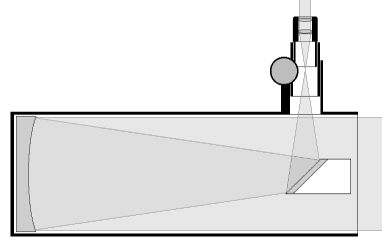"Newtonian" Reflectors
Reflecting telescopes use a concave mirror to focus the light, instead of a lens. Unlike the normal mirrors you find in the bathroom, these mirrors have the reflective coating on the reflecting side of the mirror instead of the back. This means that the light does not have to travel through the glass of the mirror, practically eradicating chromatic aberration. Mirrors are also much easier to make and you will find that the price of a reflecting telescope is much lower per mm of aperture than that of a refractor. Telescope mirrors can even be made by the amateur astronomer, adding another great feature to this type of scope.

The problem with reflecting telescopes is that the light focused by the main mirror travels back the way it came and just placing the eyepiece at the correct position, the focal point, would not work since this would be right in front of the mirror. In other words, you would block your own view. To overcome this problem, there are a number of solutions and Sir Isaac Newton was the inventor of the simplest one. Telescopes using this configuration are therefore often called Newtonian telescopes.
The Newtonian telescope features a second flat mirror which intercepts the light beam from the main mirror and reflects the light sideways, allowing you to catch the light from the outside of the telescope. This type of telescope is very popular with astronomers who want big apertures, as it offers very good value for money. There are, however, a number of disadvantages to this type of scope. Firstly, the secondary mirror causes an obstruction in the incoming beam of light which not only causes a slight reduction in brightness, it also tends to reduce the sharpness of the image slightly. This is particularly apparent in Newtonians with very short focal lengths, or so called fast Newtonians (f/4 to f/5). Another disadvantage is that Newtonians tend to be more sensitive to misalignment of the optics, and it may therefore be necessary for the owner to re-collimate the telescope every now and again. This is, however, not very difficult. In ‘Using Telescopes’ you will find out how it is done.
Another disadvantage is that the scope is usually open at the front end, making it easier for dust to gather inside. Cooling down times are longer because the telescope is prone to internal air turbulence which causes temporary image deterioration. Long focal length scopes can also be very bulky and difficult to handle.
Nevertheless, Newtonian telescopes have earned their place in the hall of fame for being excellent scopes for people who are interested in observing dim deep space objects, and these scopes perform very well at low to medium magnification and for wide field observation. Because of their generally fast focal ratios they are also ideally suited to astro photography.